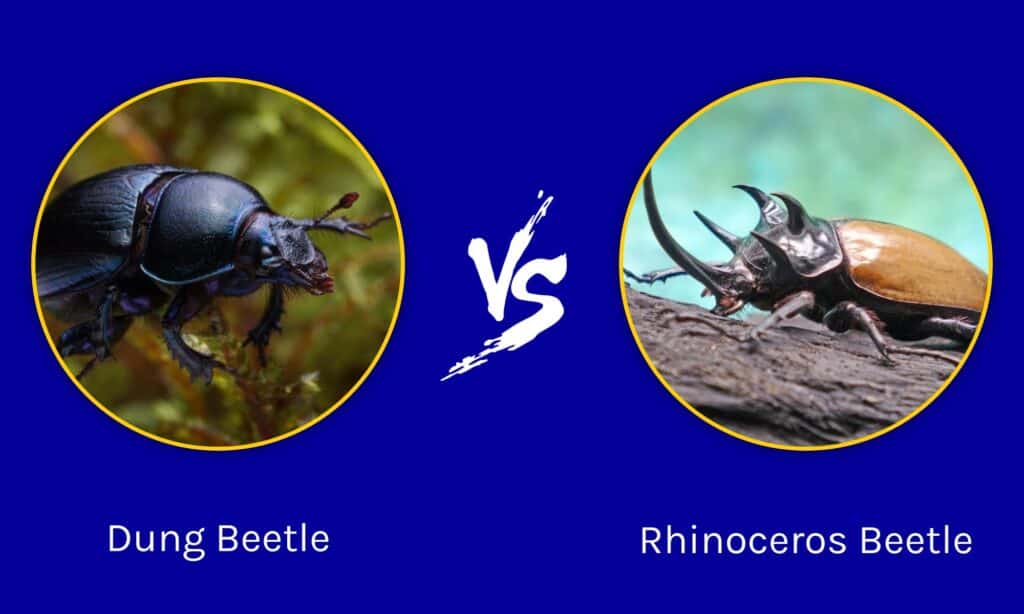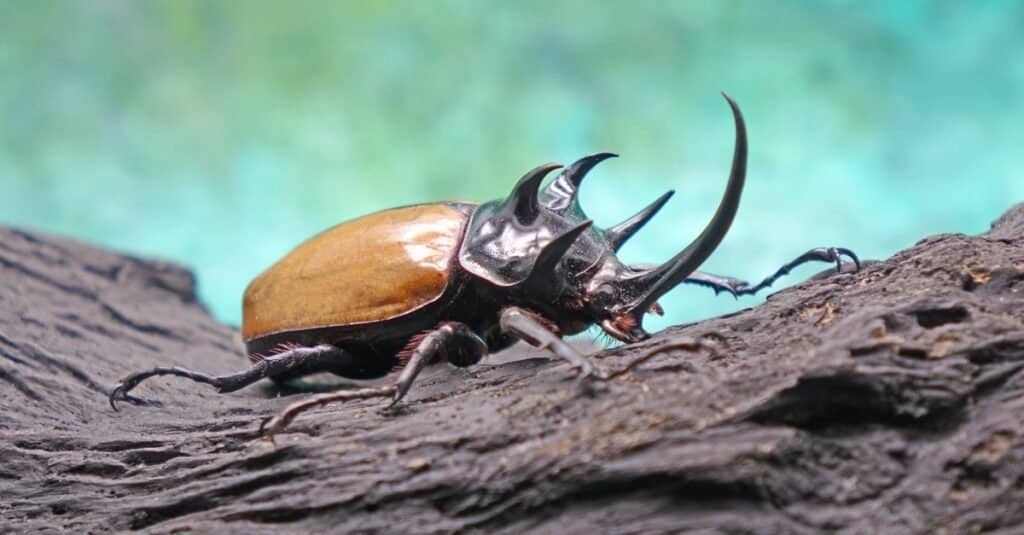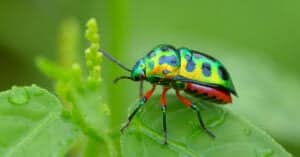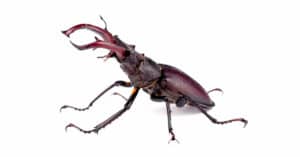Beetles are one of the most numerous insects in the world. Some families of beetle have more distinct species than other types of insects have in total! Two of the most interesting members of the Coleoptera order of beings are the dung beetle and the rhinoceros beetle. Even though they’re both beetles, they have many important differences. That’s why we’re going to take some time to compare and contrast the dung beetle vs rhinoceros beetle, showing you how they’re alike and unique.
Comparing a Dung Beetle and a Rhinoceros Beetle

| Dung Beetle | Rhinoceros Beetle | |
|---|---|---|
| Size | Weight: up to 3.5 ounces Length: 0.5-2.5 inches | Weight: 0.2-1.2 ounces, up to 8 ounces in the case of Megasoma actaeon Length: 0.5-3 inches, up to 7 inches counting the Hercules beetle |
| Morphology | – True dung beetles have specialized mouthparts that help them handle and feed on dung – Their molar lobes help them grind organic pieces in dung – Appear in black, metallic green, and red – Some males have horn-like structures on their heads to help them fight other mates – Possess spurs on their legs to help roll the dung – Hard exoskeleton – Chitinous forewings and membranous hindwings – Can pull up to 250 times their weight or more in some cases | – Many species have sizable horns used to battle other males – Some species have longer horns than others, including the Hercules beetle and Japanese rhinoceros beetle – Most are black, green, gray, or yellow – Cylindrical body – Have a hard exoskeleton – Have chitinous forewings with membranous hindwings |
| Diet | – True dung beetles consume feces from omnivores and herbivores – Eat solid dung as larvae and liquids from dung as adults | – Herbivorous – Rotten wood, tree sap, nectar, and some types of fruit – Larvae prefer rotting wood |
| Species | – Superfamily Scarabaeoidea – Families Geotrupidae and Scarabaeidae, but not all members use dung – Subfamilies Scarabaeinae and Aphodiinae – Scarabaeinae has the “true dung beetles” because most feed only on dung | – Dynastinae subfamily of Scarabaeidae, the scarab beetle family – 1500 species and 225 genera of rhinoceros beetles exist – Includes the Hercules beetle |
| Range and Habitat | – Found on every continent throughout the world except Antarctica – Commonly found in forests, deserts, fields, and farmlands – Dung beetles either roll dung to their storage area, tunnel under the dung, or dig into the dung to feed. | – Every continent except Antarctica – Live in a variety of habitats like woodlands, grasslands, and farms – Often nest in rotting wood – Many species are popular pets in Asia |
The Key Differences Between a Dung Beetle vs. Rhinoceros Beetle
The biggest differences between dung beetles and rhinoceros beetles can be found in their size and diet. The average rhinoceros beetle weighs between 0.2 and 1.2 ounces and measures 3 inches long with its body alone, but larger creatures can weigh up to 8 ounces and 7 inches long. Meanwhile, a dung beetle weighs up to 3.5 ounces and grows 2.5 inches long.
The larvae of rhinoceros beetles consume rotten wood, but they eat tree sap, nectar, and fruit when they are adults. Meanwhile, dung beetles consume solid dung and the adults consume the liquid inside of the dung.
These are some of the major differences, but they’re not the only ones. Let’s look closer at some of the most significant ways that these two types of beetles are unique!
Dung Beetle vs. Rhinoceros Beetle: Size

Rhinoceros beetles are larger than dung beetles.
©Mark Brandon/Shutterstock.com
As we’ve already said, rhinoceros beetles are larger than dung beetles on average. The average dung beetle only weighs up to 3.5 ounces while the largest rhinoceros beetle weighs up to 8 ounces in the case of Megasoma actaeon.
Dung beetles can grow between 0.5 inches and 2.5 inches long, but rhinoceros beetles can measure up to 3 inches in body length alone. However, the rhinoceros beetle’s horns can increase their total measurement to 7 inches!
Dung Beetle vs. Rhinoceros Beetle: Morphology
Dung beetles and rhinoceros beetles have some similar elements of morphology, but major differences can be found in their mouthparts. For the most part, dung beetles are round creatures while rhinoceros beetles are more cylindrical. Both types of beetles have hard exoskeletons, a metallic sheen to their bodies, chitinous forewings, and membranous hindwings.
However, dung beetles have specialized mouthparts that help them eat dung, especially their molar lobes. While males may have horns to fend off other males, the horns of the rhinoceros beetles are far larger and appear in a variety of shapes.
Both types of beetles can move over 100 times their own weight, but the strongest dung beetle is stronger than the strongest rhinoceros beetle. It’s capable of pulling over 1,000 times its own weight! In short, the dung beetle and rhinoceros beetle have similar bodies, but they are very different if you know where to look.
Dung Beetle vs. Rhinoceros Beetle: Diet

As the name implies, dung beetles feed on animal dung.
©Michael Potter11/Shutterstock.com
Dung beetles will either roll balls of dung to a storage area, build a nest inside of the dung, or create a nest under the dung to eat it at their leisure! However, some dung beetles will try to steal the dung balls of others.
The rhinoceros beetle eats rotten wood as a larva and fruit as an adult, but dung beetles eat solid dung when they’re young and liquids from dung when they’re older. Rhinoceros beetles have large larval forms, so many of them live in or very near rotting wood to satisfy their big appetites.
Dung Beetle vs. Rhinoceros Beetle: Species
The dung beetles come from the Superfamily Scarabaeoidea and the Families Geotrupidae and Scarabaeidae. However, not every member of those families uses dung as we’ve described.
The subfamilies Scarabaeinae and Aphodiinae feed on dung for the most part, but the Scarabaeinae subfamily is described as true dung beetles since the vast majority of them feed on dung. It’s hard to say precisely how many species of dung beetles exist, but roughly 7,000 of them have been identified.
Meanwhile, rhinoceros beetles come from the Dynastinae subfamily of Scarabaeidae, the scarab beetle family, and over 1,500 species of these beetles exist.
Dung Beetle vs. Rhinoceros Beetle: Range and Habitat
Both types of beetles are found on every continent around the world except for Antarctica. They enjoy living in woodlands, grasslands, and farms. You can even spot them in desert climates. Rhinoceros beetles will often live near rotting wood while dung beetles are always on the lookout for feces. Both are plentiful in the world, so they don’t have to look far to find them.
All in all, dung beetles and rhinoceros beetles may live in similar areas, but they are very different. Their size, morphology, and diet are some of the greatest differences. Examining the two types of beetles along those lines is crucial to seeing their distinctions.
Up Next:
- Click Beetle vs Cockroach: What are the Differences?
- Carpet Beetle vs Bed Bug: What are the Differences?
- Cigarette Beetle vs Drugstore Beetle: What are the Differences?
- Stag Beetle vs. Hercules Beetle — An Epic Beetle Battle
The photo featured at the top of this post is © Mark Brandon/Shutterstock.com
Sources
- University of Wisconsin, Available here: https://uwm.edu/field-station/dung-beetle/#:~:text=DUNG%20BEETLE%20FUN%20FACTS&text=A%20dung%20beetle%20may%20fly,is%20in%20a%20single%20night
- National Wildlife Federation (1970) nwf.org/Educational-Resources/Wildlife-Guide/Invertebrates/Rhinoceros-Beetles#:~:text=Rhinoceros beetles are found on,rhinoceros beetles during the day
Thank you for reading! Have some feedback for us? Contact the AZ Animals editorial team.






